![header=[Marker Text] body=[On January 22, 1959, twelve men died in a tragic accident at the River Slope Mine near this site. The mine had been illegally excavated beneath the Susquehanna River at the direction of the Knox Coal Company. When the force of the ice-laden river broke the thin layer of rock, over ten billion gallons of water flowed through this and other mines. This disaster ended deep mining in much of the Wyoming Valley. ] sign](kora/files/1/10/1-A-C7-139-ExplorePAHistory-a0a4u3-a_450.gif)
Mouse over for marker text
Name:
Knox Mine Disaster
Region:
Poconos / Endless Mountains
County:
Luzerne
Marker Location:
St. Joseph's Roman Catholic Church on Main Street, Port Griffith, Jenkins Twp.
Dedication Date:
January 24, 1999
Behind the Marker
After 110 men died in the deadly  Avondale Mine Disaster in 1870, the state of Pennsylvania began to impose safety regulations on mining operators. All too often, however, mine owners ignored those precautions in the rush to maximize profits. In the twentieth century the pressure to cut corners grew worse with each passing decade as coal steadily lost its market share and prices plunged.
Avondale Mine Disaster in 1870, the state of Pennsylvania began to impose safety regulations on mining operators. All too often, however, mine owners ignored those precautions in the rush to maximize profits. In the twentieth century the pressure to cut corners grew worse with each passing decade as coal steadily lost its market share and prices plunged.
In 1959, the River Slope Mine was only five years old, but it already extended well out under the Susquehanna River. The Knox Coal Company, and its lessor, the Pennsylvania Coal Company, had ignored map "Stop Lines" - where mining could not take place because of inadequate roof thickness - and continued to mine off course. State law prohibited mining within 35 feet of a riverbed, but the River Slope Mine came within 19 inches of the Susquehanna. Less than two feet of rock and gravel separated miners from 10 billion gallons of water. It was not enough.
On January 22, 1959, the roof gave way, trapping seventy-four men. Sixty-two of them would eventually escape, but twelve were never found. The Susquehanna River had smashed into the mine, creating a whirlpool that pulled the water in and flooded miles of mines throughout the Wyoming Valley. The disaster at Knox ended most deep mining in the Wyoming Valley, where it had been in decline since its peak production of 100 million tons in 1917.
Knox Coal represented one of many "contract mining" companies that came to dominate anthracite production in the mid-1900s. While the proliferation of these companies resulted in an increase of anthracite tonnage after World War II, these operations often saved costs by sidestepping safety regulations and mining with old equipment. The Knox Mine Disaster also exposed the corrupt tactics of United Mine Workers' officials, mine management, and mafia-connected interests in the mid-20th century. A grand jury investigating the cave in found seven men guilty of involuntary manslaughter and three of them also guilt of conspiracy. All the convictions, however, were overturned on appeal. It is little wonder then, that a daughter of one of the drowned miners called the disaster, the "Knox Mine Murders."
In 1959, the River Slope Mine was only five years old, but it already extended well out under the Susquehanna River. The Knox Coal Company, and its lessor, the Pennsylvania Coal Company, had ignored map "Stop Lines" - where mining could not take place because of inadequate roof thickness - and continued to mine off course. State law prohibited mining within 35 feet of a riverbed, but the River Slope Mine came within 19 inches of the Susquehanna. Less than two feet of rock and gravel separated miners from 10 billion gallons of water. It was not enough.
On January 22, 1959, the roof gave way, trapping seventy-four men. Sixty-two of them would eventually escape, but twelve were never found. The Susquehanna River had smashed into the mine, creating a whirlpool that pulled the water in and flooded miles of mines throughout the Wyoming Valley. The disaster at Knox ended most deep mining in the Wyoming Valley, where it had been in decline since its peak production of 100 million tons in 1917.
Knox Coal represented one of many "contract mining" companies that came to dominate anthracite production in the mid-1900s. While the proliferation of these companies resulted in an increase of anthracite tonnage after World War II, these operations often saved costs by sidestepping safety regulations and mining with old equipment. The Knox Mine Disaster also exposed the corrupt tactics of United Mine Workers' officials, mine management, and mafia-connected interests in the mid-20th century. A grand jury investigating the cave in found seven men guilty of involuntary manslaughter and three of them also guilt of conspiracy. All the convictions, however, were overturned on appeal. It is little wonder then, that a daughter of one of the drowned miners called the disaster, the "Knox Mine Murders."






